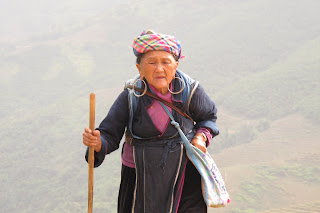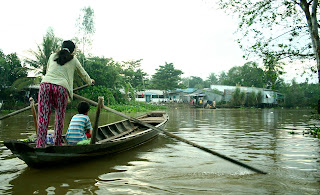Day 3:
 |
| Good Morning Vietnam! |
Our plan for day 3 was to cover some 140 kilometers almost to the border
with Laos and spend the night in the town of Dien Bien Phu. It is known for a
significant battle that took place around there in 1954 the result of which was
the expulsion of the French rule over the north of Vietnam. Since we had plenty
of time and a relatively short distance to cover for the day we took time
stopping many places to photograph the luscious landscape that was becoming
more mountainous and wooded. There were fewer villages around those parts, but
every time we saw villagers they were busy with some sort of agricultural
activity – gathering rice, carrying or cleaning crops on tarps spread along the
road.
 |
| Photo Lessons... |
The kids often road water buffalos alongside the road or zipped around on
bicycles (2-5 people on 1 bike) way too big for their size. We saw several
women who were “transporting” their pigs by walking them on a leash from one
place to another. Those villages, situated along the road, were obviously not
isolated from the rest of the civilization, but it felt as if they were
entirely self sufficient. Every household had a pond where they raised fish and
eatable algae and other water plants eaten as salad. They all had cattle,
chickens and cultivated their own rice. I am sure that the real situation is
not that ideal, but it really felt that those people lived independently
relying only on themselves and their land.
 |
| A Girl from Sapa. |
a |
| Limestone Mountains... |
Day 4: Dia: Dien Bien Phu – Lai Chau: 212 km, 8 hs.
This was one of the longest days we had on a bike and I was
not feeling too happy about it. As the landscapes were getting more and more stunning,
my butt was getting more and more sore. We took several stops during which I
had to take short naps to try to get some strength back, but it seemed that my
body was refusing to take any more time on top of that thing. Emi did not feel
the effects as much, but I think it was because he was the one driving, and
being in control took his mind away from his pains and aches. Thankfully, the scenery was gorgeous and
diverse with plenty of things to distract ourselves with.
 |
| On Their Way to the Rice Fields. |
Alongside the road we
were on there was a steep wall of a limestone mountainous formation completely
covered with a green carpet of voluptuous vegetation. The other side of the
road dropped down to a wide turbulent river the color of milk chocolate. There
were strange looking wooden boats with some sort of sheds floating in many
places. Those boats, as we later found out, were gold-digging vessels that
sifted through the river bottom residue in search of this precious metal. As we
moved farther and farther north, we noticed that traffic almost dropped
completely up there and it was almost strange to come across a random truck of
another motorbike. Apparently, the north of Vietnam is less populated and
people have fewer resources to contribute to long distance traffic.
 |
| Yummm! |
 |
| Just Another Day in the Mud Pool! |
Our adventure for the day was not exactly over with the
insect lunch. Once we finally got to Lai Chau, I was desperate for a shower and a bed.
We found a beautiful room at a family hotel and were ready to settle in when
the owner asked us for our passports to register. 5 minutes later he showed up in
our room telling us that we had to leave…Since no one at the place spoke
English we never found out what happened and why we were being kicked out. Our
only guess was that guests with US passports were not welcomed there. The north
of Vietnam is still very communist and the memories of the Vietnam War are
still too fresh in the older generation’s memory. In general, the Vietnamese
are very friendly to anyone and we have not heard any stories about animosity
towards US visitors. However, I would not be surprised if that man refused to
extend his hospitality to visitors from the nation that did horrors to his homeland
and his people.
Day
5: Lai
Chau – Sapa – Lao Cai: 157 km, 5 hs.
 |
| Villages Around Sapa. |
 |
| An Indigenous Woman in Some Village. |
Unfortunately, any interaction
with the local people turned out to be negative. Emi went to the market square
to look at the crafts and within seconds he was surrounded by at least 20 women
shoving their crafts into his face and shouting over each other to get his
attention.
 |
| A Woman from Sapa. |
The worst part was that they fought with each other and did not
respect each other’s prices or priority as far as making contact with a
particular tourist. It was also practically impossible to “shop around” and
check out prices because as soon as you asked “How much?” you were expected to
buy the thing no matter what, and if you tried to leave they physically blocked
your way! This was the worst harassment I have ever experienced and it was
really sad because it made you want to run from the place that is amazingly
beautiful, with rich history and nice people (I am sure). It really felt like “cultural prostitution”
the way those women used their traditional clothing to get your attention and
then sell you anything from what they wore or owned.
 |
| Another Indigenous Woman Selling Crafts. |
It was very sad and
unpleasant, but this is Sapa’s reality which was created by the western visitors.
So we are to blame ourselves for wanting to see exotic beautiful places and
people, and creating mass tourism to these places. We are the ones who change
the traditional life style in places like Sapa, and now we are the ones who
criticize the locals for losing their authenticity and trying to make money off
of us?!
Luckily, our visit to Sapa was soothed by a visit to a small
local bar with refreshing beer, super friendly owners and plenty of paint to
add our contribution to the decoration of the place. Having replenished our
forces and done with sightseeing for the day we left for Lao Cai, which was
going to be our last stop before heading back to Hanoi.
The last day was going to be the
longest day riding and the poorest one in attractions. This time, the goal was
not to see things but to get to Hanoi as soon as possible and in one piece. We
actually had an option to avoid driving the bike back and take a train, but
that, of course, was an ungrounded extra expense for our budget. So we got up
and drove… all day long! It was not particularly interesting and exciting, as
we were on one of the main highway routs in the north, but because of that we
saw more exciting atrocious variations on driving Vietnamese style… There were
people on motorbikes carrying slaughtered pigs, cages with chickens and dogs;
there were cows, buffalos and people walking on the highway; we had to swerve
around a bus going backwards in our lane; but the best was a heavy-duty
commercial truck parked on the actual road while the driver was having
lunch. Nevertheless, as always, we never
saw one accident and no one appeared stressed about traffic.
 |
| A Perfect Turn on the Road! |
By 6pm we were back
in Hanoi, which met us with its usual energetic chaos. Very tired but
reenergized emotionally by our new tip experiences we returned the bike,
arranged a new adventure for Hallong Bay the next day, picked up our big
backpacks from our old host and dripped them of at the house of our new hosts -
this time 4 French university students. They were very new to Vietnam, so just
like that Catalan couple, we were now the ones sharing our road stories and
inspiring the newcomers not to stick to established tourist routs and get on
those bikes to explore the country for themselves...




































